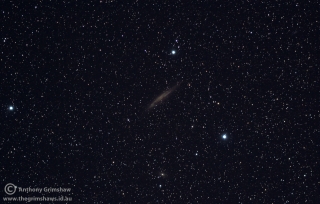My First Image of a Galaxy (NGC4945)
Well as you probably know I am a member of the BAS and we have regular club events out at Hazeldean once a month. This month was a particularly good event with a great turn out of both BAS and SEQAS members so all up around 25 Telescopes and 40 – 50 people gathered. I thought I would take the opportunity to try my first image of a Galaxy and see how it turned out.
This image was taken on Saturday 21st April 2012, at around 10:30 PM in Hazeldean QLD, Australia. The seeing conditions were about an 8/10 as there was a lot of moisture in the air, this was still pretty good considering rain was forecast :).
I used my Canon EOS 600D DSLR to take the image and the exposure times were as follows:
- 600 Seconds at ISO 100 * 3 Frames
- 600 Seconds at ISO 200 * 1 Frame
I realised at that stage that there was a problem with my guiding and the stars were a bit out (egg shaped), as I really wanted to get about 2 hours of imaging time I decided to reset everything and re-align the mount. This turned out to be a bad choice as I did not have any success and after a few hours of fiddling about and still not getting it to work I succumbed and had a glass of wine instead. Sometimes things just don’t go as planned :).
For processing the image I used Deep Sky Stacker, I didn’t use any Darks, Flats or Bias frames in the stacking process, after the images were stacked I adjusted the levels slightly, saved it and uploaded for viewing.
A little more info about the Galaxy you can see in the image (if you look closely you will see a number of other distant galaxies in the image):
- Name: NGC4945
- Type: Spiral Galaxy
- Magnitude: 8.6
- Constellation: Centaurus
- Distance: 11.7 Million Light Years
- Other Designations: PGC45279 and Caldwell 83
Discovered by James Dunlop in 1826 the spiral galaxy NGC 4945 is a close neighbour of the Milky Way in the constellation of Centaurus and is thought to be quite similar to the Milky Way Galaxy in shape and size. X-ray observations show that NGC 4945 has an unusual, energetic, Seyfert 2 nucleus that might house a large black hole.
For such a close galaxy at 11.7 Million Light Years away NGC 4945 is easy to miss, located only six times farther away than the prominent Andromeda Galaxy. The thin disk galaxy is oriented nearly edge-on and is shrouded in dark dust so you will need a telescope to see it. Despite the difficulty in finding it, it is one of the brightest galaxies within the Centaurus A/M83 Group.
I hope you enjoy my image 🙂
Most of the information above was from Wikipedia
Cheers
Anthony
